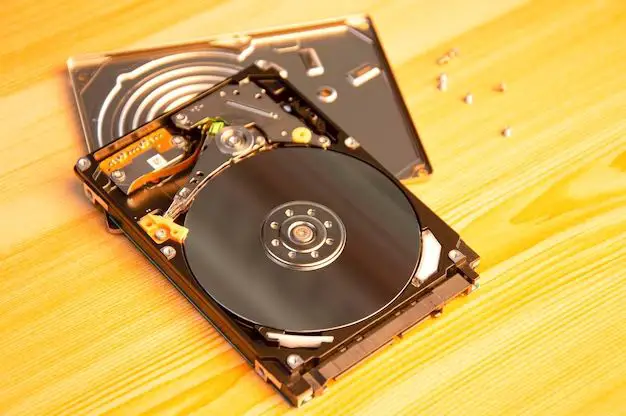Hard drives are able to store data without power through the use of non-volatile memory technologies that retain information even when the power is turned off. The most common technology used for this is magnetic storage, which uses materials and recording heads that can flip the magnetization of tiny spots on the drive platters to represent 1s and 0s. This magnetic orientation remains in place whether the drive is powered on or off, allowing the data to persist.
How Hard Drives Work
A typical hard drive consists of one or more rigid platters coated in a magnetic recording material, stacked on top of each other and spun at high speeds by a motor. Read/write heads float just above the surface of each platter, accessing data as the platters rotate.
The data itself is recorded by magnetizing small regions on the platter surface. A magnetic field from the head orients the magnetic particles to represent either a 1 or 0 bit. The presence or absence of a magnetic field at a specific spot codes the binary data.
Hard drives use non-volatile recording media, meaning the magnetic orientations representing the data are locked in place and don’t require constant power to maintain their position. So when the drive is powered down, the 1s and 0s stay put, allowing the data to be accessed when the drive is powered on again.
Magnetic Recording
The magnetic material coating the platters is made up of tiny magnetic grains. Each grain acts like a tiny magnet that can be polarized one way or the other to represent data bits.
Industry standards designate that a grain oriented in one direction represents a 1, while an opposite orientation represents a 0. The read/write head generates a strong magnetic field that can flip the grains into the desired alignment as the platters spin past.
A grain’s magnetic polarity remains locked into position until rewritten by the head. This persistence is what gives hard drives their non-volatile storage capabilities. Power is only needed to change or read the data, not to maintain it.
Write Process
During a write operation, the hard drive’s read/write head receives an electrical signal based on the binary data to record. As the platter rotates under the head, the signal modulates the orientation of the head’s magnetic field. This field aligns the magnetic grains on the platter into the pattern representing the 1s and 0s of the data.
The grains maintain this alignment after the write head passes by. Essentially “etching” the binary data pattern onto the platter surface. Once written, the data remains stored in place on the inactive disk, ready to be accessed later when the drive is powered back on.
Read Process
When reading data, the head passes back over the magnetized grains representing the written data. The magnetic fields from the grains induce tiny electrical signals in the head. The head converts these into the original 1s and 0s of the data, which is then decoded by the drive electronics.
No electrical current or magnetism is needed to maintain the written grains. The platter holds the magnetic pattern representing the data whether the drive is powered on or off. This allows the data to be reliably retrieved after power cycling the drive.
Main Data Storage Technologies
While magnetic recording is the primary technology used to store data non-volatilely in hard drives, some newer drives may incorporate other types of non-volatile memory.
Magnetoresistive Random-Access Memory (MRAM)
MRAM uses magnetic tunnel junctions — two ferromagnetic plates separated by a thin insulating layer. Data is stored by orientating the magnetic fields of the two plates into parallel or anti-parallel configurations. MRAM maintains this magnetic orientation when power is removed, providing non-volatile storage.
Resistive Random-Access Memory (ReRAM)
ReRAM cells have a memristor made of two metallic layers separated by an insulating oxide material. The resistance across the cell can be altered by applying voltage pulses, allowing data values to be encoded. The resistance state remains stable when unpowered.
Phase-Change Memory (PCM)
PCM cells use a material that can be quickly switched between crystalline and amorphous states by heating and cooling it. The different electrical resistances of these two states represent 1s and 0s. The cell maintains this phase state whether powered or not.
Non-Volatile Memory Advantages
The use of non-volatile memory technologies like magnetic recording gives hard drives several key advantages:
- Data persistence – Information remains saved even when powered off.
- Fast access – Data can be quickly read and written when powered on.
- High capacity – Ability to store large amounts of data in a small form factor.
- Low cost per bit – Affordable data storage compared to other solutions.
- Data integrity – The drive retains stable data when powered off unexpectedly.
Conclusion
Hard disk drives are able to retain data without constant electrical power through the use of non-volatile recording media. This enables permanent or long-term data storage with quick access when the drive is powered on. Magnetic recording using oriented magnetic grains is the predominant technology that enables hard drives to save data indefinitely while powered off.
| Non-Volatile Memory Type | Description |
|---|---|
| Magnetic recording | Uses oriented magnetic grains on a platter to store data bits |
| MRAM | Magnetic tunnel junctions switched into parallel/anti-parallel states representing 1s and 0s |
| ReRAM | Memristor cells with alterable electrical resistance to encode data values |
| PCM | Phase change material toggled between crystalline and amorphous states to store data |

